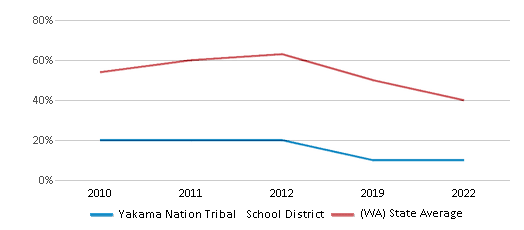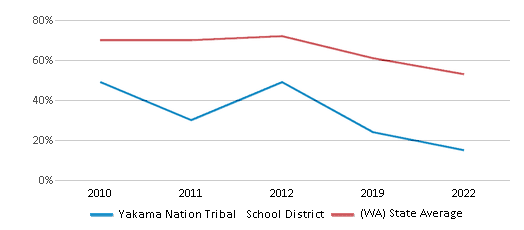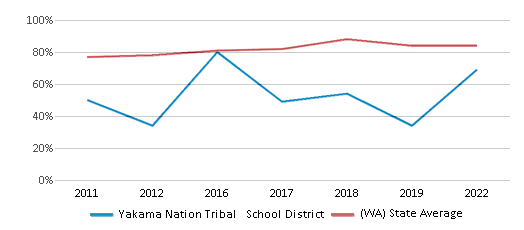For the 2025 school year, there is 1 public school serving 153 students in Yakama Nation Tribal School District.
Public Schools in Yakama Nation Tribal School District have a diversity score of 0.00, which is less than the Washington public school average of 0.69.
Minority enrollment is 100% of the student body (majority American Indian), which is more than the Washington public school average of 52% (majority Hispanic).
Overview
This School District
This State (WA)
# Schools
1 School
2,566 Schools
# Students
153 Students
1,102,146 Students
# Teachers
6 Teachers
62,276 Teachers
Student : Teacher Ratio
26:1
26:1
District Rank
The school district's graduation rate of 60-79% has decreased from 80% over five school years.
Math Test Scores (% Proficient)
≤10%
40%

Reading/Language Arts Test Scores (% Proficient)
11-19%
53%

Science Test Scores (% Proficient)
11-19%
49%
Graduation Rate
60-79%
84%

Students by Ethnicity:
Diversity Score
0.00
0.69
# American Indian Students
153 Students
14,078 Students
% American Indian Students
100%
1%
# Asian Students
n/a
97,776 Students
% Asian Students
n/a
9%
# Hispanic Students
n/a
284,937 Students
% Hispanic Students
n/a
26%
# Black Students
n/a
52,279 Students
% Black Students
n/a
5%
# White Students
n/a
529,041 Students
% White Students
n/a
48%
# Hawaiian Students
n/a
15,944 Students
% Hawaiian Students
n/a
2%
# Two or more races Students
n/a
97,439 Students
% of Two or more races Students
n/a
9%
Students by Grade:
# Students in PK Grade:
-
24,937
# Students in K Grade:
-
76,570
# Students in 1st Grade:
-
77,991
# Students in 2nd Grade:
-
81,918
# Students in 3rd Grade:
-
78,358
# Students in 4th Grade:
-
81,181
# Students in 5th Grade:
-
81,842
# Students in 6th Grade:
-
80,681
# Students in 7th Grade:
-
81,501
# Students in 8th Grade:
19
82,250
# Students in 9th Grade:
28
86,778
# Students in 10th Grade:
43
88,758
# Students in 11th Grade:
22
87,587
# Students in 12th Grade:
41
91,794
# Ungraded Students:
-
-
Best Yakama Nation Tribal School District Public Schools (2025)
School
(Math and Reading Proficiency)
(Math and Reading Proficiency)
Location
Grades
Students
Rank: n/an/a
601 Linden St
Toppenish, WA 98948
(509) 865-4778
Toppenish, WA 98948
(509) 865-4778
Grades: 8-12
| 153 students
Frequently Asked Questions
How many schools belong to Yakama Nation Tribal School District?
Yakama Nation Tribal School District manages 1 public schools serving 153 students.
What is the racial composition of students in Yakama Nation Tribal School District?
100% of Yakama Nation Tribal School District students are American Indian.
What is the student/teacher ratio of Yakama Nation Tribal School District?
Yakama Nation Tribal School District has a student/teacher ratio of 26:1, which is higher than the Washington state average of 18:1.
Recent Articles

Sexual Harassment at Age 6: The Tale of a First Grade Suspension
A six-year old in Aurora, Colorado, was suspended after singing an LMFAO song to a little girl in his class and reportedly “shaking his booty.” We look at the case and the sexual harassment problem in public schools today.

How Scaffolding Could Change the Way Your Child Learns
This article explores the concept of instructional scaffolding, a teaching method that enhances learning by breaking down complex tasks into manageable parts. It highlights how scaffolding supports students in developing critical thinking skills and becoming more independent learners. The article discusses the benefits of scaffolding, including improved engagement and reduced anxiety, and provides strategies for its implementation across various educational levels.

February 05, 2025
Understanding the U.S. Department of Education: Structure, Impact, and EvolutionWe explore how the Department of Education shapes American education, from its cabinet-level leadership to its impact on millions of students, written for general audiences seeking clarity on this vital institution.





